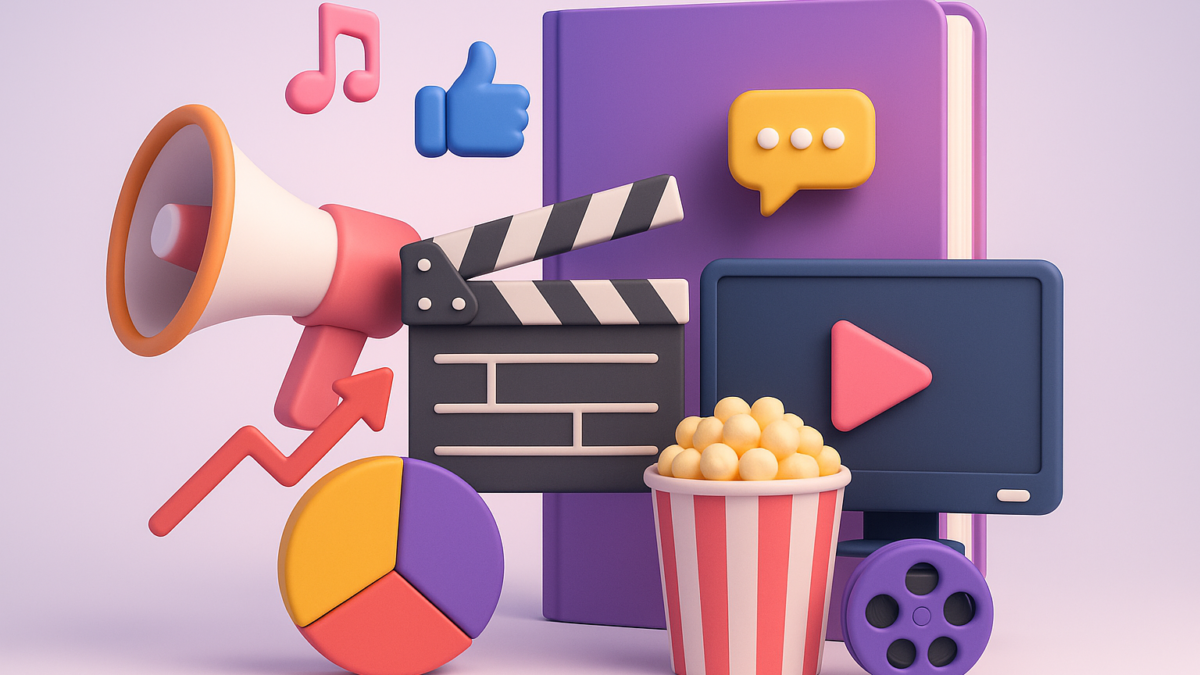Entertainment Marketing: Strategies That Captivate Audiences in 2025
The world of entertainment has never been more competitive. With streaming wars, gaming expansions, and immersive digital experiences taking center stage, entertainment marketing has evolved from flashy ads to storytelling-driven campaigns designed to connect with audiences on a deeper level.
From Marvel’s billion-dollar movie rollouts to Netflix’s AI-powered personalization, entertainment brands are rewriting the rules of marketing. In this blog, we’ll explore what entertainment marketing is, why it matters, and the strategies that are shaping the industry in 2025.
What is Entertainment Marketing?
At its core, entertainment marketing is the art of using storytelling, experiences, and cultural trends to engage audiences while promoting films, TV shows, music, games, and live events. Unlike traditional product marketing, entertainment marketing thrives on emotional connection, community building, and cultural relevance.
Think of Beyoncé’s surprise album drops, Disney’s multi-platform storytelling, or the Barbie movie’s global marketing campaign—each is a masterclass in building hype and sustaining cultural conversations.
Why Entertainment Marketing Matters in 2025
The way people consume content has changed dramatically:
- Streaming Platforms Rule: 80% of global consumers now prefer streaming services over traditional cable.
- Gaming as Entertainment: The gaming industry is projected to surpass $300 billion by 2025.
- Short-Form Content Boom: TikTok and Instagram Reels dominate how Gen Z and Millennials discover new entertainment.
- AI & Personalization: Platforms like Spotify and Netflix thrive because they personalize recommendations.
For entertainment brands, marketing is no longer about selling a ticket—it’s about creating an ecosystem of engagement.
Key Strategies in Entertainment Marketing
1. Storytelling Beyond the Screen
Entertainment brands today don’t just sell content—they sell stories that expand across platforms. Marvel, for example, uses movies, TV shows, comics, games, and merchandise to create a multi-channel universe.
Pro Tip: Create transmedia storytelling campaigns that extend your brand narrative across podcasts, AR apps, and digital communities.
2. Influencer & Celebrity Partnerships
Influencers and celebrities have become the new media channels. A TikTok challenge tied to a song can turn it into a global hit overnight. Case in point: Lil Nas X’s “Old Town Road” went viral because of TikTok challenges before hitting the charts.
How to Apply:
- Partner with micro-influencers to reach niche fan bases.
- Use celebrity tie-ins for global reach (think Nike x Travis Scott).
- Run interactive campaigns that encourage user-generated content.
3. Immersive Experiences (AR, VR & Metaverse)
The entertainment industry is embracing immersive marketing. From virtual concerts in Fortnite to AR movie posters, brands are creating interactive fan experiences.
Example: Warner Bros. launched a Matrix-themed metaverse experience, allowing fans to interact with characters and exclusive content.
Why It Works: Immersive experiences make fans feel like participants rather than spectators.
4. Data-Driven Personalization
Streaming platforms have set a new standard for personalized marketing. Netflix tailors artwork, trailers, and recommendations to each user, increasing watch time and retention.
How Brands Can Use This:
- Use AI tools to personalize ads and recommendations.
- Segment audiences based on behavior (music fans, gamers, binge-watchers).
- Create custom landing pages for different demographics.
5. Cross-Industry Collaborations
The Barbie movie campaign in 2023 was a case study in brand partnerships—from fashion (Zara x Barbie) to gaming (Roblox experiences). These collaborations extend reach beyond traditional entertainment audiences.
Ideas for 2025:
- Music x Gaming crossovers (exclusive album drops in games).
- Film x Fashion tie-ins with capsule collections.
- OTT platforms x Tech brands for bundle promotions.
6. Social Media Virality
Short-form content platforms like TikTok, YouTube Shorts, and Instagram Reels are non-negotiable in entertainment marketing. Viral trends can make or break a campaign.
Tips for Going Viral:
- Tap into trending sounds and memes.
- Create fan challenges tied to content.
- Encourage fan remixes, duets, or mashups.
Real-World Examples of Winning Entertainment Marketing
- Netflix’s Stranger Things: Interactive billboards, social media cryptic posts, and immersive VR experiences turned the series into a cultural phenomenon.
- Taylor Swift’s Eras Tour: Marketing blended social media hype, fan-driven TikTok trends, and personalized ticketing strategies.
- Marvel’s Avengers Campaign: Multi-year buildup using teasers, Easter eggs, and interconnected storylines across films and digital platforms.
Each of these campaigns used multi-channel storytelling, fan engagement, and cultural relevance to dominate headlines and drive massive revenue.
The Future of Entertainment Marketing
Looking ahead, entertainment marketing will be defined by:
- AI-Powered Content Creation (automated trailers, personalized ads).
- Fan-First Campaigns (user-generated stories and co-creation).
- Sustainability-Driven Branding (eco-conscious merchandise and events).
- Hyper-Immersive Experiences (metaverse concerts, interactive films).
Entertainment brands that adapt will not only survive but thrive by making fans feel like active participants in the story.
Conclusion
Entertainment marketing in 2025 is about more than promotion—it’s about building worlds, experiences, and cultural moments that audiences want to be part of. By embracing storytelling, influencers, immersive tech, and fan-driven campaigns, brands can keep audiences engaged long after the credits roll.
Call-to-Action
Want to amplify your entertainment brand’s reach and ensure your content connects with the right audience? Leverage the power of B2B content syndication to distribute your stories across premium platforms and maximize visibility. Discover our B2B content syndication services today.
S Als: Beyond Gated PDFs: Reinventing Whitepapers for the Experience-Driven Buyer





